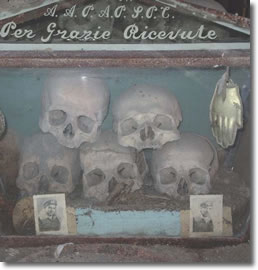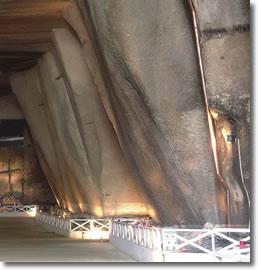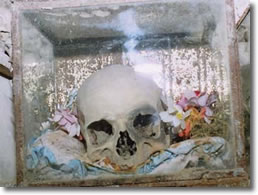Warning! The template for this page [systemPrint.html] doesn't exists.
The Cemetery of the Fontanelle: the anecdotes

- The "pezzentelle" souls
The cult of the souls in Purgatory - The pezzentelle souls
In the document written by the canonical and archaeologist Andrea De Jorio there is a clear reference to the transformation at the end of the 18th century of the quarry into a place of worship ("...a wall and an altar were built.."). From the mid of the 19th century, a group of women called "e' maste" of the Sanità district rearranged all the mortal rests who had been piled inordinately inside the cavity during various eras. All the bones were arranged near the tufa walls following precise schemes and groupings. This tradition is commemorated with a gravestone outside Maria S. S. del Carmine Church. The gravestone, which can be dated back to the end of the 19th century, represents a commemoration for all those people who died because of the pestilence, poverty or in prison and that for this reason were considered "anonymous" mortal rests.
Gaetano Barbati, founder and promoter of a project for all the "lost souls", coordinated the work of rearranging the mortal rests. In March 1872, the Fontanelle cemetery was opened to the public. Thanks to Barbati and Cardinal Sisto Riario Sforza the first quarry was temporarily used as a Church. On the 13th of May in 1877the first mass took place in the cementery.

- The Cementery of Fontanelle entrance
In 1884, people started to reorder anonymous bones and skulls. People used to take care of the"lost souls", who repaid the attention received blessing those whotook care of them.
As a sign of devotion, people used to "adopt" their own skull, putting inside the shrines votive images or personal messages. The large number of devote urns at the Cementery of Fontanelle represent people's faithful to the graces received through the intercession of the souls in pain. "E' maste" women were those who helped people to find their soul. Inside the cemetery, religious processions took place, moreover, people used to recite poems, as the following one:
Holy souls, souls in Purgatory,
I am alone andyou are a lot
Please, tell Godmy sorrows
Before it is too late and night arrives during this holy day
I need to be comforted by God
Merciful Godwith thy redeemed blood
Greetings to all the souls in Purgatory,
Eternal Rest
Legends

- Captain's skull and the black eyehole
What characterized such an evocative place were the personifications of the souls inpain, as Lucia, a young girl who died before her wedding, men died in war, princesses and knights. Sometimes the skulls have a history and a name that are transmitted through stories passed over time, as it happened for the"Monaco" (or Paquale's head) that reveals the winning numbers of the lottery, the "Captain" head, which is the symbol of the cementery and "Donna Concetta" 's head that is also know as the sweating head. Another important aspect are the legends about children, as the story about "Pasqualino".
"I was whatyou are, you'll be what I am"
Death
What was very common was the adoption of skulls which were put inside shrines, they were venerated in order to receive a favour or for the miracles realized by the skulls themselves. Many legends started to be told, as the story of the two skulls that sweat or on the "Captain" 's head.
The "captain" skull was adopted by a poor girl, who decided to venerate the "head" in order to find a husband. The girl succeeded in findingher husband and before going to the mass wedding, she went to the cementery to thank the skull. The day of the wedding, everyone was impressed by the presencein the Church of a man dressed as a Spanish soldier. The soldier smiled and winked to the bride, whose husband, jealous of what had just happened, hit the soldier's occiput.
When the bridegrooms came back from the honeymoon, the bride when to thank her skull again. What she found there was a skull with a completely black eyehole. This event was considered to be a miracle and from that moment, the skull was called the"captain" 's skull.
Some messages found in the skulls
Dear souls, let me know your names.
Dear souls, please let me win the lottery.
Dear souls, please help me...
Naples, April,3rd 1944
The Armistice took place and it is eight month since we have not seen our son, please help usto see him again. Family Aviere Lista Ciro


